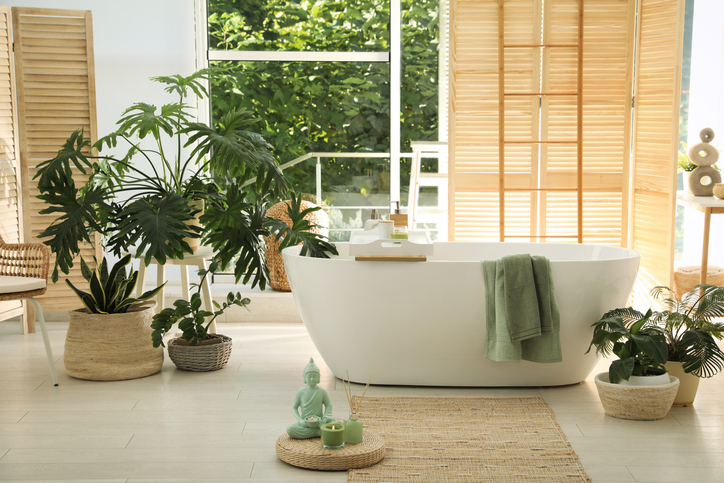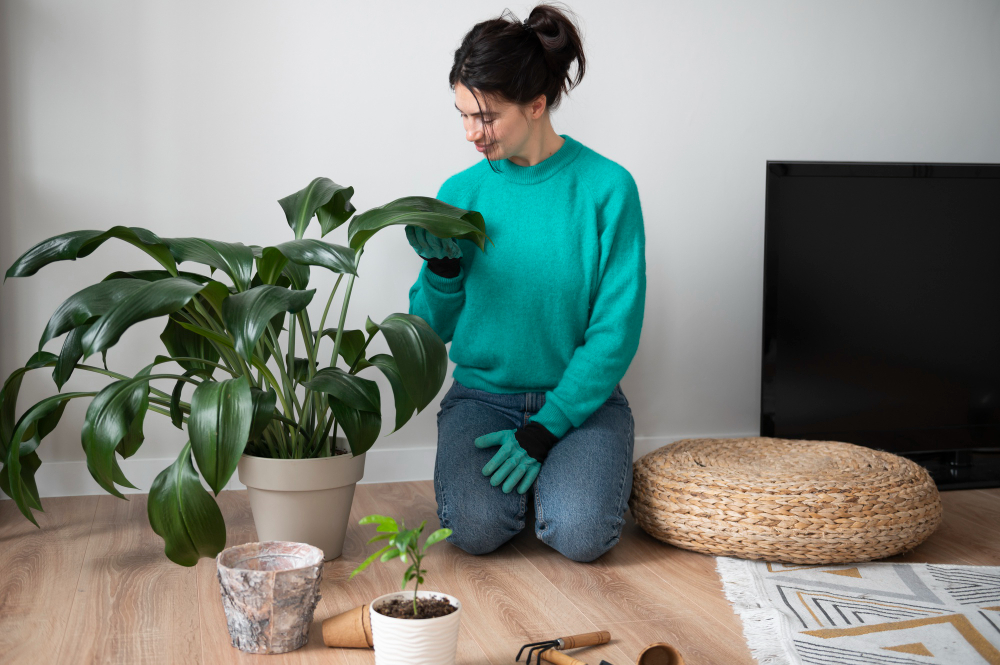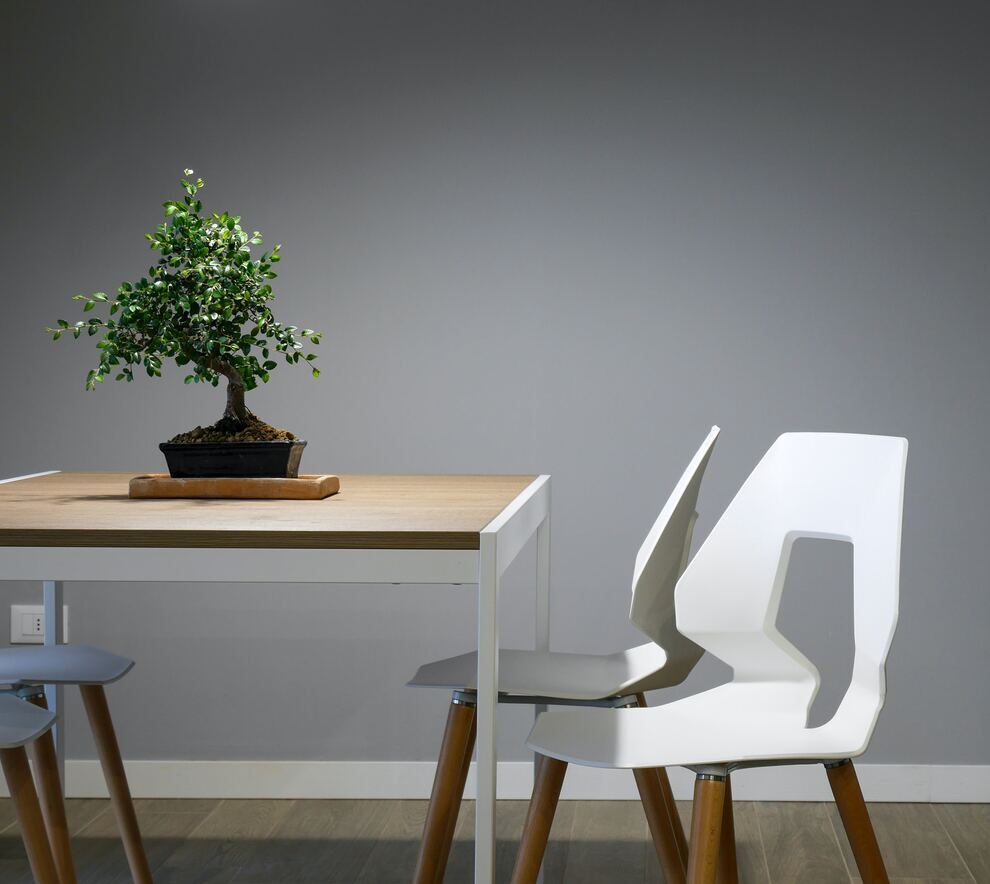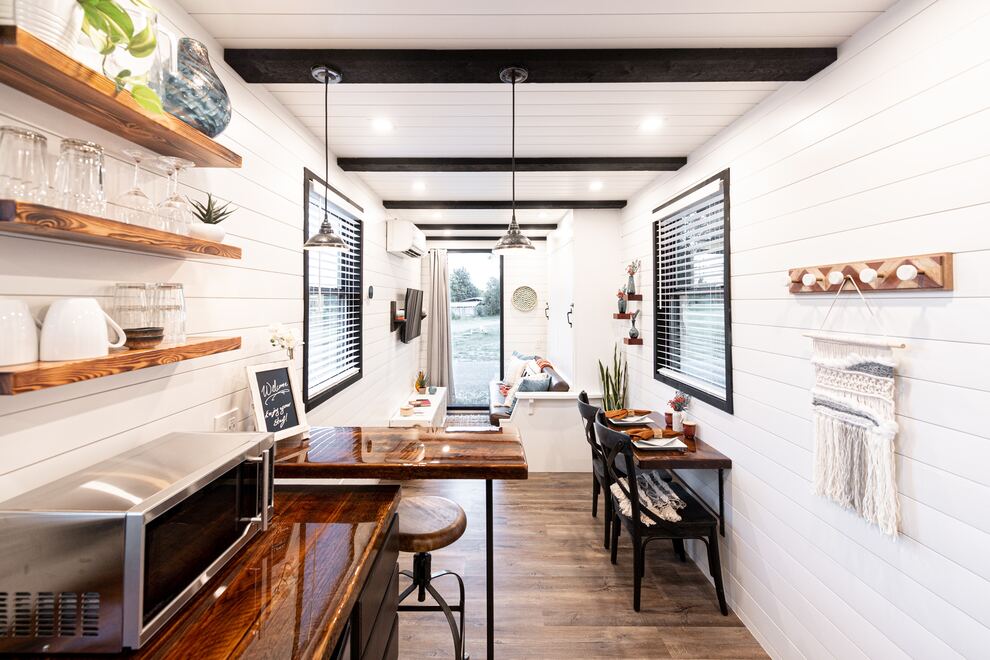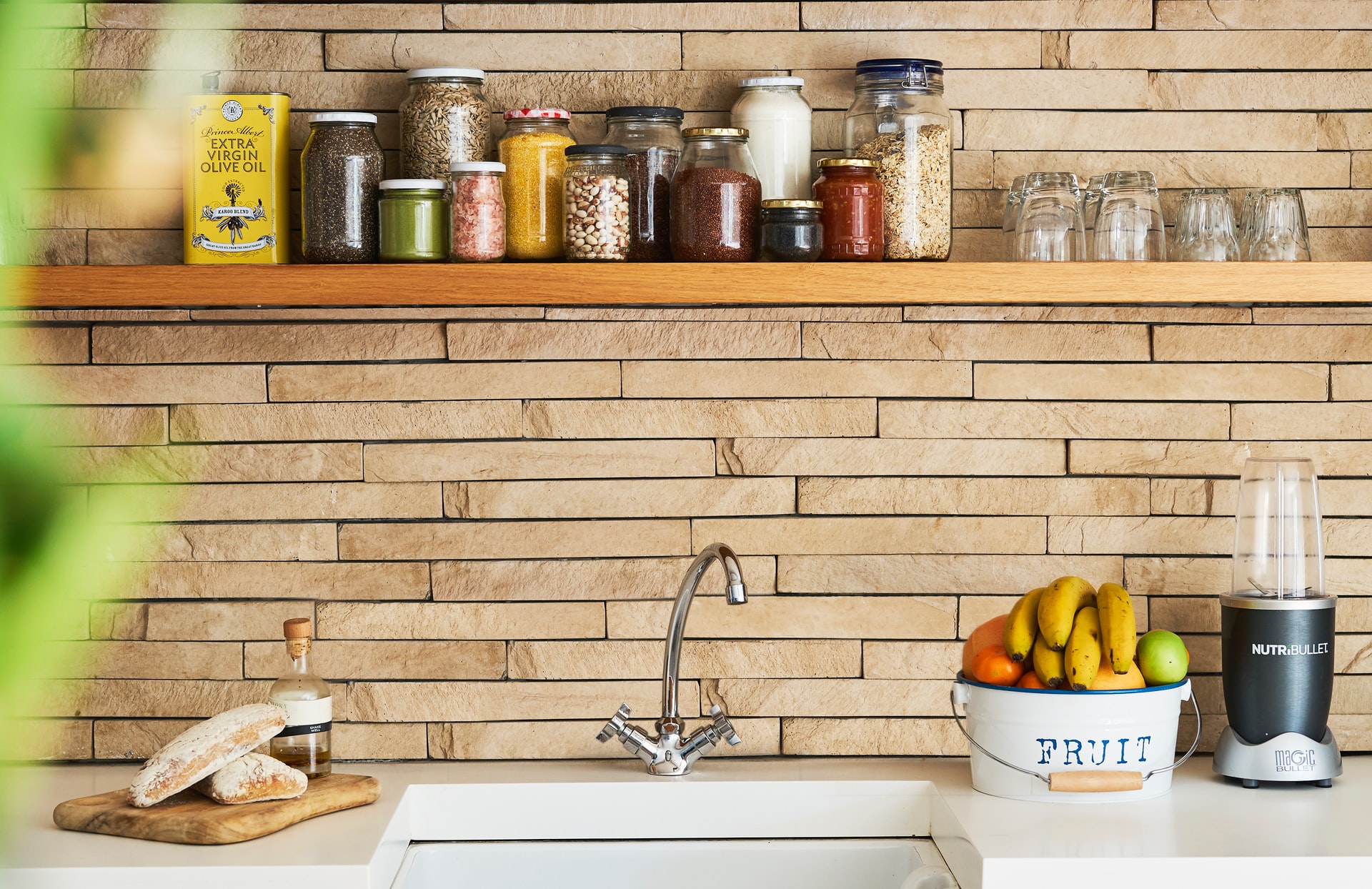Sitting by a river, listening to the leaves rustle in the trees in your backyard, taking a breath of fresh air – nature has a way of improving our physical and mental health. The biophilic home design embraces the human-nature connection by incorporating natural elements into your home.
Whether building a new house or decorating your current one, there are a few ways to enjoy a greener space’s many physical and mental health benefits.
Exploring biophilic home design
Biophilic home design is a way of bringing the outdoors in, creating spaces that make us feel more connected to nature. Imagine stepping into a home where natural light filters through large windows, plants thrive in every corner, and materials like wood and stone create a calming environment. This design approach incorporates natural elements into our living spaces to improve our physical and mental well-being.
What is biophilic home design?
Biophilic design is about reconnecting with nature through our built environments and creating spaces that give us the same sense of peace and harmony we feel when outside in nature. Stephen Kellert, a social ecologist, explained that biophilic design involves two main ideas:
- Incorporating elements that remind us of nature into our homes. This can be as simple as using materials like wood and stone or adding plants and water features. Bringing these natural elements inside helps create calming and stress-free environments.
- Connecting the home to its local environment. This can mean designing spaces that invite exploration and curiosity, like using natural patterns and textures that engage our senses and make us feel more connected to our surroundings.
Benefits
Biophilic home design offers a range of benefits that extend beyond mere aesthetics, positively impacting both physical and well-being.
Well-being
- Stress reduction: Greenery and water features in your home create a peaceful ambiance, lowering cortisol levels associated with stress. Simple activities like admiring a green wall or listening to a water fountain can induce a sense of calm.
- Mood improvement: Exposure to natural light and the presence of plants can elevate serotonin levels, fostering better mood and overall happiness. This positive environment aids in combating feelings of depression and tiredness.
Physical health
- Better sleep quality: Natural light exposure regulates melatonin production, which is key to a healthy sleep cycle. Homes with ample sunlight promote waking up naturally and feeling refreshed.
- Indoor air quality: Houseplants such as peace lilies, spider plants, and snake plants absorb toxins and release oxygen, purifying the air in your home. This can help to reduce the risk of respiratory problems and allergies.
Productivity and creativity
- Focus and concentration: Natural elements in the workspace can improve concentration and reduce mental fatigue. Studies have shown that views of nature or natural elements can increase attention span and cognitive performance.
- Boosted creativity: Being surrounded by natural forms and materials can inspire creativity and innovation. Natural light, colors, and textures can stimulate the brain and boost problem-solving abilities.
Higher property value
- Appeal to buyers: Homes designed with biophilic principles are highly sought after in the real estate market. Features like energy-efficient systems, sustainable materials, and natural aesthetics attract environmentally-conscious buyers and those desiring a healthier living space.
- Market differentiation: A home with biophilic design elements stands out in the market. Features like green roofs, living walls, and indoor gardens can make your property more attractive than conventional homes, potentially leading to a higher selling price.
Energy efficiency and cost savings
- Lower utility bills: Biophilic design often includes the use of natural ventilation and passive solar heating, which can significantly lower heating and cooling costs. Features like skylights and large windows reduce the need for artificial lighting during the day.
- Sustainable living: Incorporating energy-efficient appliances, solar panels, and sustainable building materials from a reliable building materials ecommerce platform reduces your carbon footprint and long-term maintenance costs. This approach ensures that your home remains eco-friendly and cost-effective over time.
Key elements of biophilic home design
According to Kellert, there are six key elements of biophilic design:
- Environmental features: Embrace the human-nature connection by incorporating pieces of the natural world, like plants, animals, and organic materials. Colors, water, and airflow are also important to consider. Letting ivy grow over the front of your home is one way to embrace environmental features.
- Natural shapes and forms: If you’re building a new home, consider designing the exterior to imitate the shapes and forms found in nature. You can incorporate animal motifs like hives and webs inside and outside the home. Avoid right angles and embrace natural curves.
- Natural patterns and processes: Although this element might sound similar to shapes and forms, this is more about using natural properties to enhance the built environment. If you go outside, you’ll instinctively respond to the variations and richness of detail you can find in a park or hiking trail. Consider bringing that same richness into your home to use this element.
- Light and space: Natural and filtered daylight comes with a number of benefits for our physical and mental health. What’s more natural than your circadian rhythm? Another way to approach light is to consider the relationship between light and shade, as well as the uses of reflected light. Space gives you a sense of openness. It’s especially important to consider transitional spaces. How do you want your home to feel as you step out onto the porch or other outdoor living space? How does that outdoor living space embrace its natural surroundings?
- Place-based relationships: This element is where culture meets ecology. People have deep, strong connections to certain places. These connections go deeper than “I have family there” or “This is where I grew up.” We have real biological ties to geographic and historical features, local ecosystems, and landscapes. By embracing this emotional connection with nature at home, you’ll feel more stewardship and pride in your property.
Evolved human-nature relationships: This element focuses on the fundamental aspects of our relationship with nature. Nature offers a sense of safety, protection, balance, curiosity, and exploration. A biophilic home offers those same senses.
How to incorporate biophilic home design
Now that you know the basics, you can do a few things to feel the soothing effects of nature at home. Whether you focus on organic architecture or interior design, there are a few simple things you can do to incorporate this soothing home aesthetic.
Plan ahead
Before making any major changes to your home, plan ahead to ensure your project goes smoothly.
Find licensed professionals: Leave yourself time to find professionals who can provide references for their work. This will help you end up with a well-crafted and lasting design. Ask at least three pros for quotes and references to ensure you’re getting the right price from the right person.
Set a budget: When you’re redesigning a room or your entire house, it’s easy to go wild purchasing decor and doing extra projects for the perfect look. Set a budget and track your expenses to avoid unexpected debt.
Check your home insurance: Check with your home insurance agent, as some renovations can increase the value of your home and affect your insurance coverage. Some insurance providers may request proof of renovation permits or inspections before renewing your policy. If you don’t inform them about your renovations, your coverage could be voided, or you may not have enough coverage to protect your investment. Liability coverage protects against injuries due to features like water elements, natural materials, or uneven surfaces. Property damage coverage helps safeguard the home, ensuring that elements like large windows or unique shapes like fountains and forms are covered.
Let the natural world in
This might be the easiest thing you can do to incorporate biophilic design: open your windows. Let fresh air and the sounds of nature into your home. Listen to birds singing, rain falling, or even just the wind rustling leaves on a tree. Breathing in fresh air is good for your immune system function, and fresh air can even improve your mood.
Maximizing the amount of natural light in your home is a good idea, too. Consider adding a skylight or opening curtains and blinds in the morning. Replace the black door with sliding glass doors. If you have a screen door or storm door in the front, you can even leave the front door open while you’re home to catch some afternoon light and a little extra vitamin D.
Add some houseplants indoors
Bringing in houseplants is a great way to build on the human-nature connection. Indoor plants have been shown to reduce stress levels and purify indoor air. Houseplants can even help you stay focused and enjoy better cognitive function.
Of course, if you’re not an avid gardener, make sure to invest in easy plants. ZZ plants, pothos, and sansevieria are all great options if you’re just stepping into the world of indoor plants. These plants also do well without a lot of light. Keep in mind how much light you have in your home, and ask the garden supply center workers for advice on which plants might be best for your space. Just because a particular plant is popular on Instagram doesn’t mean it’ll thrive in your home’s environment.
Incorporate natural materials
Embrace natural materials like wood and stone. Wood and stone veneer give the same effect at a lesser cost. Consider natural finishes that let you see the organic patterns in wood flooring. You can DIY some of these projects or bring in a local handyman to achieve that natural look.
Accent pieces in cotton or natural linen bring texture and an organic look to any room. A live-edge dining room table is a great way to embrace biophilic design in your living space. Do your best to choose sustainable materials that are responsibly sourced. Embracing biophilic design means embracing nature and being a steward of the land, so keep that in mind when shopping for materials as well.
Use natural colors
We are drawn to greens, blues, and browns. These hues have a calming effect on our minds and bodies. Choosing colors found in nature will give your home a cohesive look, even if you have a wide variety of colors and textures from room to room. Take a cue from the great outdoors; flowers come in bright colors, but the backdrop is usually green, brown, or blue. Use brighter colors in small doses for a natural effect.
Connect to the outdoors
We’ve talked about bringing the outdoors in, but you can do a few things to make that transition outdoors seamless. If you have a deck or patio, create an outdoor living space with comfy patio furniture and an outdoor area rug.
Bring in some potted plants, a plant cover lawn, or a water feature for a smooth transition from your indoor to your outdoor living space. By making an outdoor living space, you’re gaining square footage for entertaining while maintaining a smooth transition from your home to the yard or garden.
Sustainable building practices
Sustainable building practices are a natural extension of biophilic design, making sure that nature is integrated into our homes responsibly and thoughtfully. Using sustainable materials and incorporating green features like living walls and green roofs makes your home more eco-friendly and contributes to greater environmental conservation efforts. These elements help reduce energy consumption, improve air quality, and support local ecosystems, making your home part of the solution to environmental challenges.
- Eco-friendly materials: Opt for sustainably sourced materials with a low environmental impact. Bamboo, reclaimed wood, and recycled metal are excellent choices. These materials reduce the demand for new resources and add a unique aesthetic to your home.
- Energy efficiency: Incorporating energy-efficient technologies into your home design can significantly reduce your carbon footprint and lower your bills. Install LED lighting, which mimics natural daylight patterns, improving focus and regulating circadian rhythms. Use energy-efficient appliances and consider installing solar panels to harness renewable energy.
- Water conservation: Implement water-saving fixtures and systems in your home. Low-flow toilets, faucets, and showerheads, as well as rainwater harvesting systems, can help conserve water. Additionally, incorporating native plants and xeriscaping in your outdoor spaces reduces the need for irrigation.
- Natural ventilation and insulation: Design your home to take advantage of natural ventilation. Large windows, skylights, and strategically placed vents can keep your home cool in summer and warm in winter, reducing the need for artificial heating and cooling. Use sustainable insulation materials, such as sheep’s wool or recycled denim, to improve energy efficiency.
- Green roofs and walls: Besides improving the aesthetic appeal of your home, they provide insulation, reduce urban heat island effects, and improve air quality. These features can be particularly beneficial in urban settings, offering a touch of nature where green space is limited.
- Sustainable landscaping: Use native plants and organic gardening methods. Native plants require less water and are better suited to the local climate, reducing maintenance and resource use. Composting organic waste and using natural fertilizers can also enhance soil health and plant growth.
- Passive solar design: Design your home to make the most of natural sunlight for heating and lighting. Orienting your home to maximize sun exposure in the winter and minimize it in the summer can reduce reliance on artificial climate control. Overhangs, pergolas, and shade trees can help manage solar gain effectively.
- Biodegradable and low-VOC products: Choose paints, finishes, and building products that are low in volatile organic compounds (VOCs) and biodegradable. These products improve indoor air quality and are less environmentally harmful during their lifecycle.
Waste reduction: During the construction or renovation process, aim to minimize waste. Reuse materials whenever possible and recycle construction debris. Consider deconstruction instead of demolition to salvage usable materials for other projects.
Top 3 biophilic home design projects
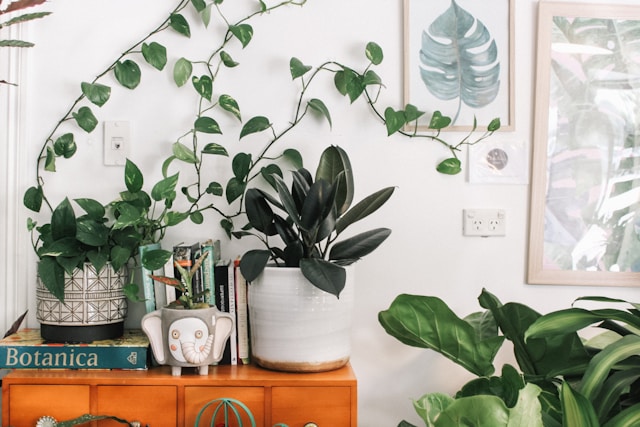
If you’re looking for more inspiration, there are three simple DIY projects you can do to incorporate biophilic home design:
- A living green wall: Imagine a wall covered in your favorite plants so your home looks like a jungle. You can do this project indoors or outdoors. Living walls are modular systems attached to walls to hold different plants. Some come with interior integration, and others are as simple as turning a wood pallet into a planter. You can even buy wall-mounted planters and use them to hold vining houseplants, like pothos, to achieve a similar effect.
- Natural wood accent walls: This project allows beginner DIY homeowners to add some dimension and texture to their walls. Measure your wall so you know how much wood to buy, and then sketch a pattern. Use four boards to frame the wall. You can make a grid or panel pattern on the wall from there. Then, paint or stain the wood pieces.
- Tabletop indoor fountains: Enjoy the soothing flow of water in your home with a simple tabletop fountain. You can purchase a tabletop fountain online or make your own to save a little money. Invest in a pretty, watertight bowl and some decorative rocks. All you have to do then is buy a small fountain pump and fill the bowl with water and rocks. If you have a larger table, consider using a planter and a bowl to make tiers. Some fountain pumps come with remote controls, so you don’t have to worry about leaving the fountain running.
By bringing in some elements of the natural world, your home can become the soothing, restorative retreat of your dreams. Whether you are an avid gardener, just getting into houseplants, or inspired by the beautiful colors of the ocean, you’ll enjoy reconnecting with the beautiful planet we live on — all from the comfort of your home.
